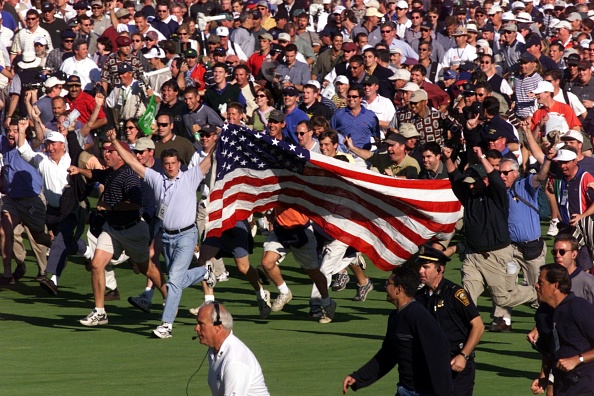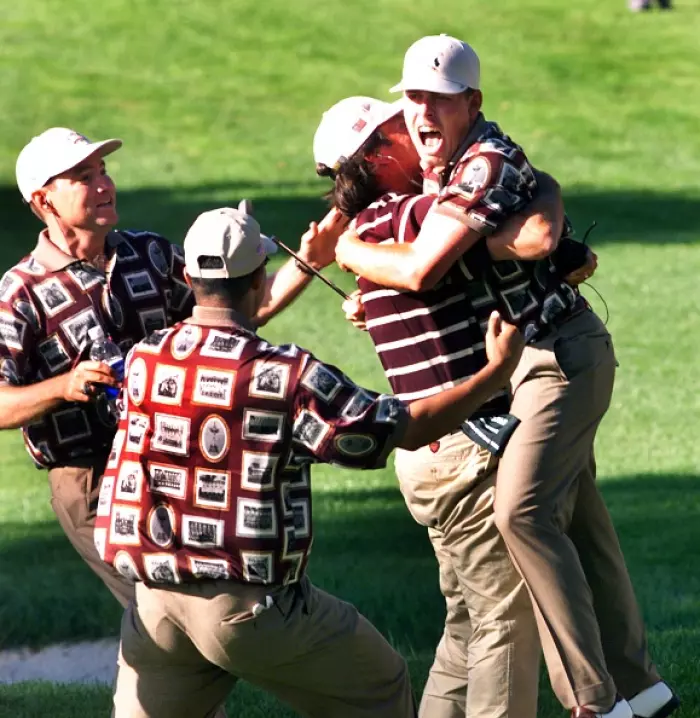“Don’t throw up.” These opening words of John Feinstein’s book A Good Walk Spoiled were all that PGA tour veteran Davis Love III could think of on his 18th and final hole at the Belfry in Warwickshire, England, in 1993. He managed to hold on to his breakfast and defeat Italian Constantino Rocca one up, giving the USA its 24th victory in the Ryder Cup.
But how has the Ryder Cup evolved from an exhibition match for touring professionals to a competition that gives seasoned golf pros the big shakes?
The cup’s origins lie in a trip by 11 American professional golfers to Gleneagles in Scotland for the 1921 British Open (or “The Open Championship”, for golf pedants). Subsidised by subscription and intended as a showcase of the quality of American professional golf, the team arrived in the UK to find the suggestion of a match against Great British professionals reported in The Times.
The contest was won by Great Britain 9-3. But despite the disappointing match result, the trip was ultimately a success, with Jock Hutchison, one of the 11 American players (albeit originally coming from Scotland), winning The Open at St Andrews.
Five years later, in 1926, it was announced that the wealthy UK seed merchant Samuel Ryder would present a trophy for an “annual competition between British and American professionals”. This marked the inception of the Ryder Cup, but it wasn’t until the following year that the competition was organised on a formal basis.
The cup’s original iteration was four 36-hole foursomes matches (with players hitting alternate shots) and eight 36-hole singles matches (the modern version consists of two days of four foursomes in the morning and four fourballs in the afternoon, and a third day when all 12 players play singles).
The first official Ryder Cup was played at Worcester Country Club in Massachusetts in 1927. The Americans won 9 ½ to 2 ½. This gave the legendary US golfer Walter Hagen the honour of being the first captain to lift the Ryder Cup.
America’s love affair with golf started in the late 19th century, but truly took off in the Roaring Twenties.
This explosive growth in the game’s popularity was disastrous for Great Britain in the Ryder Cup. From 1935 to 1983, the Americans ran riot, with Great Britain notching up just one victory and one tie in 21 contests.
Despite the lopsided record, there were still a number of highly competitive contests during that period, the most notable being in 1969 at Royal Birkdale in north-west England.
On the links at Birkdale, Tony Jacklin and Jack Nicklaus went toe to toe in what US captain Sam Snead later referred to as the “greatest golf match you have ever seen in England”. Nicklaus famously conceded a two-footer to Jacklin to halve their match and the Ryder Cup. This was seen as either the ultimate gesture of sportsmanship or highly controversial (depending on which side of the Atlantic you came from). However, ultimately it had no impact on the Americans, who retained the cup in the event of a tie as current holders.
Great Britain became Great Britain & Ireland in 1973 but the most significant change to the Ryder Cup came in 1979 with the inclusion of Continental European golfers in an attempt to make the contest more competitive. The creation of a “Team Europe” and the inclusion of Spanish wunderkind Seve Ballesteros in 1979 and young German Bernhard Langer in 1981 helped to breathe life back into the contest and usher in a newly competitive era.
The new European team won the cup in 1985, breaking a two-decade drought, and retained it on US soil in 1987.
In 1989, American frustrations boiled over at The Belfry. Early in his singles match on the final day, Ballesteros claimed his ball was scuffed and unfit for play (allowing him to put a new ball in play under the rules at the time). US team member Paul Azinger disputed this and the rules official sided with the American. Ballesteros returned serve on the 18th hole, uncharacteristically questioning whether Azinger had taken a correct drop after hitting into a water hazard.
Thus was born one of the greatest Ryder Cup feuds of all time, and the competition entered the “Bad Blood” era of the 1990s.
 US fans storm the 18th fairway at the 1999 Ryder Cup. Photo: Bill Greene/Boston Globe/Getty.
US fans storm the 18th fairway at the 1999 Ryder Cup. Photo: Bill Greene/Boston Globe/Getty.
Tensions between the two teams were high leading into the 1991 cup at Kiawah Island Golf Resort in South Carolina. The Americans added fuel to the fire at the ceremonial opening dinner, playing a video of Ryder Cup highlights that showed only American players and not a single European.
Contentious rulings, alleged poor sportsmanship and a particularly boisterous American crowd led to what many consider to be the most intensely competitive Ryder Cup ever played. Players from both sides were brought to tears by the pressure of the final singles day in what would be dubbed “The War on the Shore”.
The event culminated in one of the most dramatic putts in golf history. Bernhard Langer came up the 18th hole tied with Hale Irwin and needing a win to retain the cup for Team Europe. Langer conceded a bogey putt to Irwin and found himself with a six-foot par putt to win the match and retain the cup. He missed, and the Americans took back the coveted trophy after three consecutive losses.
The War on the Shore at Kiawah Island is generally considered to be responsible for the widespread popularity of the cup today.
The bad blood continued through the 1990s as the two teams traded blows, with Europe winning in 1995 and 1997. This culminated in the “Battle at Brookline” in Boston in 1999, when the increasingly boorish behaviour of American fans reached its pinnacle.
On the 17th hole of the Justin Leonard-José María Olazábal’s must-win singles, the celebrating US team and their wives stormed the green after Leonard sank a long birdie putt but before Olazábal had had a chance to hit his shorter birdie attempt. They trampled Olazábal’s intended line and he missed the putt, guaranteeing an American victory.
Accusations of the “Rise of the Golf Hooligan” followed, and the incident prompted complaints from the Europeans and apologies from the American players. After this, organisers made a concerted effort to reduce the increasingly nationalistic atmosphere at the cup.
The 21st century has seen the continued rise in popularity of the transatlantic contest, driven by several exhilarating performances.
“The Miracle at Medinah” in Illinois in 2012 is undoubtedly the most famous such contest, where a white-hot Ian Poulter helped the European team overcome a 10-6 deficit on the final day. In an echo of 1991, German player Martin Kaymer had a six-foot putt to win the cup. This time he drained it, securing the greatest comeback win in the competition’s history.
Team Europe are the current holders after their convincing win at Le Golf National near Paris in 2018. But next weekend, they come up against a powerful American team full of the world’s top 10 players.
The Americans will have a strong home-team advantage as a travel ban on European tourists to the US means the crowd will be almost entirely rooting for Team USA. In addition, the competition is taking place at the notoriously difficult Pete Dye-designed Whistling Straits course in Wisconsin. This will suit the “bomb and gouge” Americans, and Pádraig Harrington’s European team will have to play out of their skins to retain the cup.
One thing’s for sure, both teams will bring everything they have to Whistling Straits. As Tom Kite said to Davis Love III before his cup debut, “Remember one thing. If they’ve got a 60-foot putt, expect them to make it. If they’re in an unplayable spot, figure they’ll find a play. If you’re sure we’ve won a hole, flush the thought. Things are going to happen you’ve never seen happen before in your entire life.”
The 2021 Ryder Cup begins on September 24.











